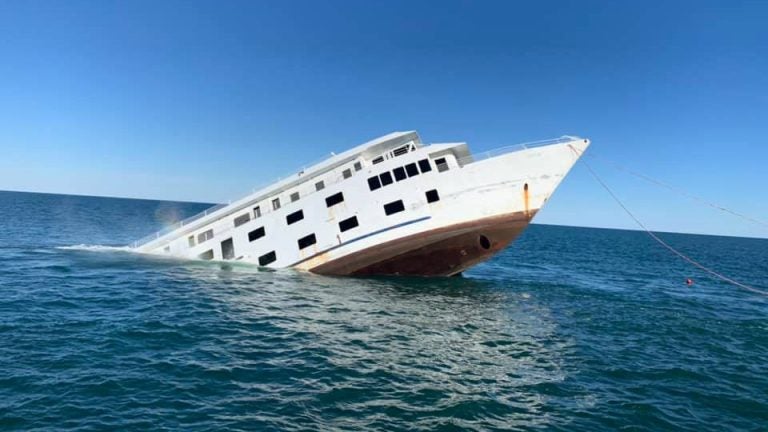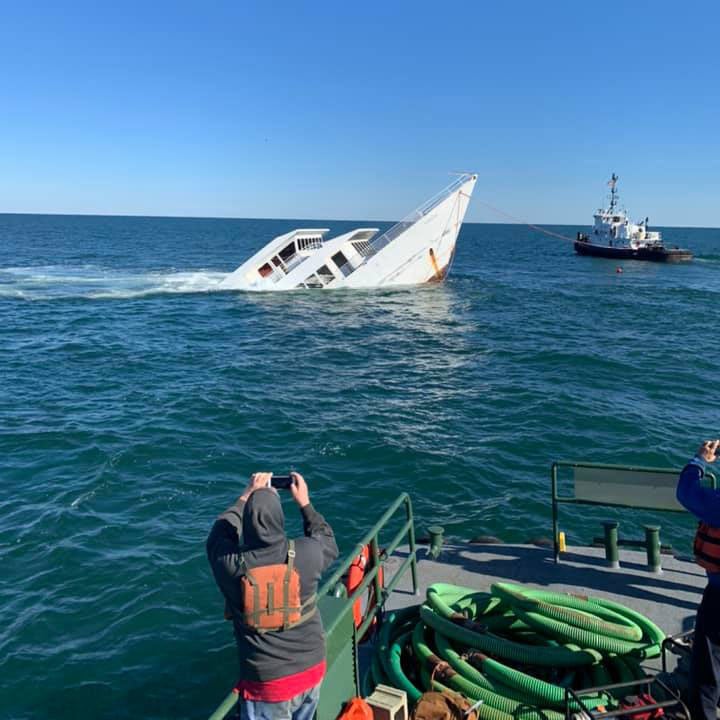215-foot-long cruise ship sinks off Del. coast, the latest addition to underwater reef
The American Glory is the latest addition to the reef off the Delaware coast. The vessel will soon become a destination for fish (and fishing enthusiasts).

The 215-foot-long cruise ship American Glory slips below the surface of the Atlantic Ocean off the Delaware coast on Monday. The ship will join hundreds of subway cars and other items to become part of the Redbird Inshore Artificial Reef. (Courtesy Chris Ragni)
There was no emergency response when a cruise ship sank to the bottom of the Atlantic Ocean about 16 miles off the coast of Delaware’s Indian River Inlet. Instead of sounding the alarm Monday, state leaders celebrated.
The American Glory is the latest addition to an artificial reef. For more than 20 years, old ships have been given new life there as a gathering site for fish on the bottom of the sea. Delaware’s Redbird Inshore Artificial Reef has also become the final resting place for nearly 1,000 New York City subway cars that bore the “redbird” paint scheme.
The latest addition to the reef carried passengers in the Chesapeake Bay and coastal waters for 15 years. The 215-foot-long ship is the largest ship of the Redbird site, which also includes tugboats, barges, and armored military vehicles.
Because the sandy underwater landscape off the Delaware coast is fairly barren, there’s not much to draw fish. Adding a few hundred subway cars and a cruise ship goes a long way to making it more attractive for both marine visitors and humans looking to see or catch them.

“By adding the structure out here, you’re creating habitat for fish that don’t have a lot of habitat out there,” said John Clark, fisheries section administrator for the state Division of Fish and Wildlife. “We know that a lot of the head boats and charter boats that take people out for fishing trips will go directly to our reefs to fish.”
The cruise ship’s multiple decks provide a big draw for both fish and underwater divers. Divers can explore four passenger decks as they swim with the fish expected to congregate around the new reef element.
“This boat sits nice and high off the bottom, so fish will be swimming in and out of what used to be the windows and all that, so it will be an interesting place to dive on, as well as a great place to fish,” Clark said.
The ships must meet Environmental Protection Agency standards before being sent to the bottom. That’s not as big a deal for a newer ship like American Glory, which first launched in 2002. Some older vessels built before 1979 had high concentrations of PCBs that had to be removed before sinking.
“Any type of contaminants are removed, and by the time they’re sunk, they are ready to go to become good fish habitat,” Clark said.
Shawn Garvin, secretary of the Delaware Department of Natural Resources and Environmental Control, said that a diverse mix of ships and other human-made material makes the reef “a fish magnet for angling action and diving excitement, and more importantly making more fish habitat for helping sustain some of our leading fisheries, including sea bass and tautog.”
Sea bass and tautog are very “structure-oriented” fish that like to congregate around objects like the American Glory. Clark said there’s a multiplier effect, as other species follow suit.
“We get some big catches reported of predatory fish such as bluefish out at the artificial reef,” Clark said. “They’ve really been an excellent advantage for our anglers.”
Redbird Reef is one of more than a dozen sites where ships and other material have been sunk. The Del-Jersey-Land Inshore Artificial Reef features the longest ship ever reefed on the East Coast, the USS Arthur W. Radford, which was sunk in 2011. Del-Jersey-Land also features a ship that survived the Battle of Iwo Jima in World War II, as well as the Twin Capes, a 325-foot-long retired Cape May-Lewes ferry that was sunk in 2018.
“Delaware’s artificial reef system continues to grow in both its renown and disparate natural resources,” Garvin said. “Our reef system is without compare in the Mid-Atlantic region.”
WHYY is your source for fact-based, in-depth journalism and information. As a nonprofit organization, we rely on financial support from readers like you. Please give today.





